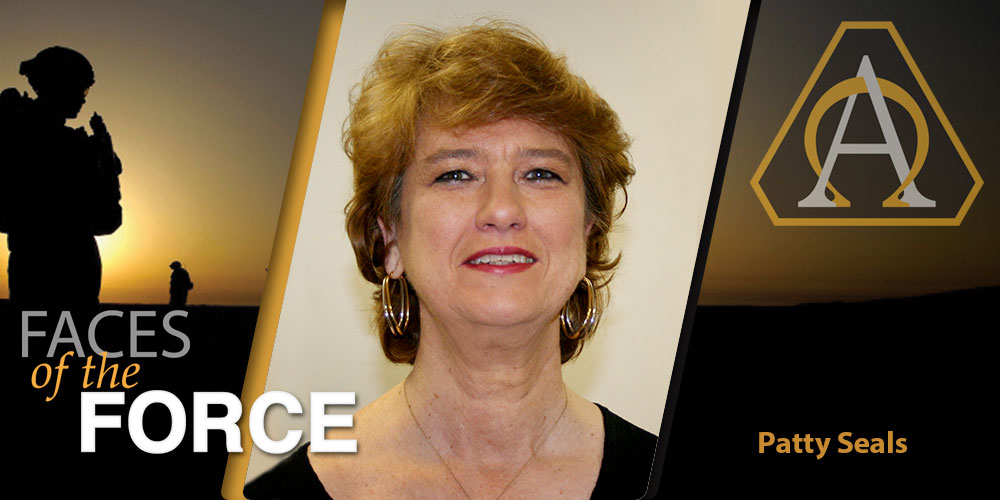
POSITION AND UNIT: Chief, Resource Management Division, Lower Tier Project Office, Program Executive Office for Missiles and Space
YEARS OF SERVICE IN WORKFORCE: 28
DAWIA CERTIFICATIONS: Level III in business – financial management; Level II in program management; Level III DOD Financial Management Certification
EDUCATION: B.S. in business, Athens State College; Certified Defense Financial Manager
AWARDS: Department of the Army Achievement Medal for Civilian Service, Commander’s Award for Civilian Service, Order of St. Barbara
Managing missile money
By Mary Kate Aylward
Managing the funds for one of DOD’s highest-profile weapon systems is, as you would imagine, stressful. But Patty Seals keeps in mind the Soldiers and the international customers who buy the PATRIOT system and reap the benefits of her budget team’s work.
Seals manages a team of nine budget analysts who keep the money flowing for the PATRIOT missile, but it’s not as simple as turning the money spigot to “on.” Because of the program’s differing regulations, requirements and pools— or “colors”—of money, she oversees the allocations to make sure each individual piece of the PATRIOT project draws funds from the correct source. “I am responsible for the Lower Tier Project Office Future Years Defense Program programming of approximately $6.4 billion and the execution of approximately $2.5 billion in annual appropriations of U.S. requirements.” (The Lower Tier Project Office was formerly the PATRIOT Project Office.) “ These funds support continued modernization of the PATRIOT system,” Seals added, “by providing modernized designs for many system elements, resulting in reduced operation and maintenance costs, obsolescence mitigation, improved warfighter-machine interfaces and system performance improvements.”
Seals has also managed the funds for two Acquisition Category (ACAT) I major defense programs—the PAC-3 missile and now the follow-on missile segment enhancement—in the Army’s air defense portfolio. It’s collaborative work: “I work with offices at all levels of the Department of the Army to identify solutions in a fiscally constrained budget environment that ensures PATRIOT remains capable and robust for U.S. and international warfighters.”
“Overall, it runs pretty smoothly,” she says. “Until you’ve worked inside the government it’s hard to imagine how it works, but it does. I think I’ve put a super team together, they get along well and we all work really well together.”
Everyone in the acquisition workforce contributes to the vital work of getting Soldiers what they need to win. Seals zeroes in on what, specifically, she contributes to the mission: “making sure the funding is in place so the engineers and contractors can do their jobs.” In order to stay equipped to do that, she emphasizes “continually training, keeping my knowledge and skills up to date with current best practices and obtaining additional certifications as they become available to keep abreast of the ever-changing financial management environment—that shows that you’re willing to stay up to date with the latest technology that’s available and making sure you do your part to contribute.”
Keeping up with current regulations is key. “Managing this kind of budget well enough to know that it’s done correctly according to all the regulations and requirements … some people think, ‘Oh, you’ve got money, you can spend it on whatever you need,’ but there are other stipulations; the ‘color’ of the money is important and so I have to be very diligent about what pool of money is supposed to be used to support which requirements.”
Managing millions of dollars takes a team, so managing people is also a part of Seals’ job. “While you’re making sure money is allocated correctly, you don’t want to make anyone feel they don’t know what they’re doing. So it’s also a balance of making sure there’s no tension among the analysts I supervise.” She draws on the skills learned from “the best of the best in supervisors” she had early on in her career.
Seals entered the Army civilian workforce as a GS-4, in what was “basically a secretarial position.” Then, she says, “I started looking to get upward mobility, and I got proactive and started doing what I needed to do to get into a position with growth potential, by networking with the leaders that I had in the High Endoatmospheric Defense Interceptor office, where I worked at the time. I wanted to be a member of this dynamic team and took advantage of all of the available training. I became Level III certified in my chosen area as soon as possible, once the certification program became available in 1996.”
Moving from a secretarial role to supervisor of a team of nine is a big jump. If you’re looking to make a similar career jump, Seals offers this advice: “Be excited about your career, believe in yourself, work hard, be professional and reliable, capitalize on all opportunities such as training, teaming and mentors, and be open-minded and adaptive to change, because change is inevitable. What was good today isn’t necessarily good enough tomorrow.”
“Faces of the Force” is an online series highlighting members of the Army Acquisition Workforce through the power of individual stories. Profiles are produced by the U.S. Army Acquisition Support Center Communication and Support Branch, working closely with public affairs officers to feature Soldiers and civilians serving in various AL&T disciplines. For more information, or to nominate someone, please contact 703-664-5635.
Subscribe to Army AL&T News, the premier online news source for the Acquisition, Logistics, and Technology (AL&T) Workforce.







